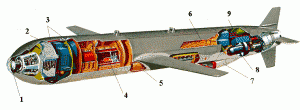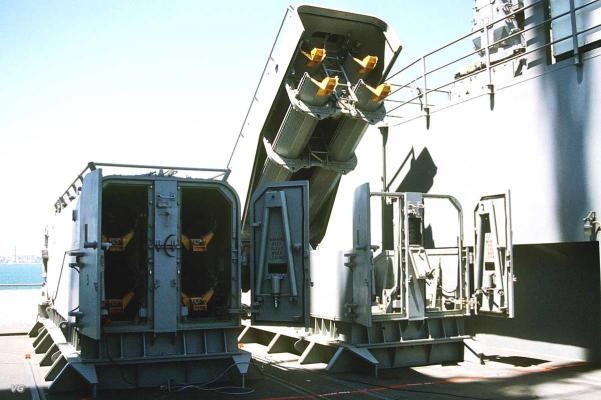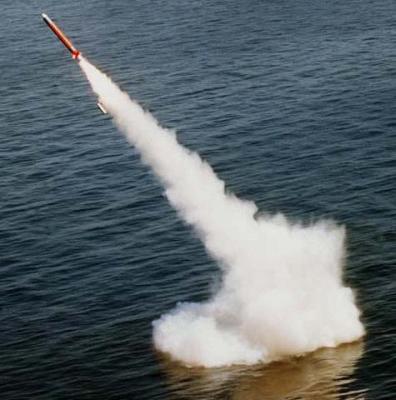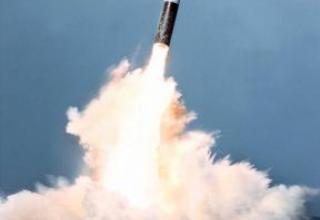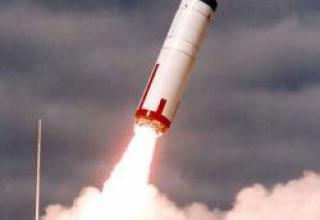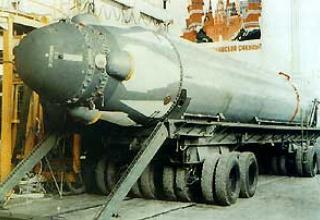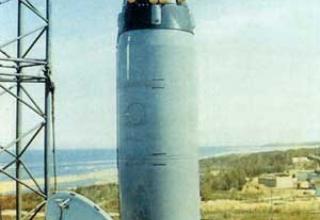The Tomahawk sea-based missile system includes surface or underwater cruise missiles, launchers, a missile firing control system and auxiliary equipment.
The Tomahawk BGM-109 cruise missile (CR) is designed in two main versions: strategic (modifications A, C, D) - for firing at ground targets and tactical (modifications B, E) - for destroying surface ships. Their structural and circuit design and flight characteristics are identical. All variants thanks to the modular construction principle differ from each other only by the head part.
Composition:
KR is made by the aircraft scheme (monoplane), has a cylindrical body with ogival fairing of the head end, folding and recessed into the body wing in the central part and cross-shaped stabilizer in the tail. The casing is made of strong aluminum alloys, graphite epoxy plastic and radio transparent materials. A special coating is applied to the body, wing and stabilizer to reduce radar visibility.
The warhead W-80 (mass 123kg, length about 1m, diameter 0.27m and power 200ct) serves as a combat unit of Tomahawk BGM-109A strategic nuclear missile. It is detonated by a contact fuse. The destruction zone radius is 3km. The high firing accuracy and significant power of the BGM-109A Tomahawk strategic missile warhead allow for the highly effective engagement of highly protected small targets. According to U.S. experts, the probability of destroying a protected object that can withstand an excess pressure of 70 kg/cm2 is 0.85 for one Tomahawk and 0.10 for the Poseidon-SSLBM.
Strategic non-nuclear CR BGM-109C is equipped with a monoblock (semicombat) BC, and BGM-109D - cassette, which includes up to 166 small-caliber BLU-97B combined action (mass of each 1.5 kg) in 24 bundles.
The Tomahawk RC control and guidance system BGM-109 A/C/D is a combination of the following subsystems (see diagram):
- inertial,
- TERCOM (Terrain Contour Matching),
- electron-optical correlation DSMAC (Digital Scene Matching Area Correlator).
The inertial control subsystem operates on the initial and middle sections of the missile's flight (mass 11kg). It includes an on-board computer, an inertial platform and a barometer altimeter. The inertial platform consists of three gyroscopes to measure the missile's angular deviation in the coordinate system and three accelerometers to determine the acceleration of these deviations. The subsystem provides the detection of the missile's position with an accuracy of 0.8 km per 1 flight.
The control and guidance system of strategic missiles with conventional warheads BGM-109C and D included electron-optical correlation subsystem DSMAC, which allows you to significantly improve the accuracy of firing (KVO - up to 10m). It uses digital pictures of pre-recorded terrain along the CR's flight path.
For storing and launching Tomahawk missiles, the submarines use OEM torpedo tubes (TA) or special vertical launch units (VLU) Mk45 (see diagram, photo), and container-type surface ships Mk143 (see diagram, photo1, photo2) or VLU Mk41.
A steel capsule (454 kg mass) filled with nitrogen at low pressure is used to store the boat version of the missile (see photo1, photo2). This makes it possible to keep the missile ready for use for 30 months. The capsule with the missile is loaded into TA or HPU like a conventional torpedo.
U.S. submarines have four bow hydraulic TAs each, positioned squarely (two at a time) at an angle of 10-12° to the ship's diametric plane, and provide for firing from great depths, which significantly reduces the disguising factors. The TA tubes are made of three sections: bow, central and stern. Loading and correct positioning of the CR capsule in the TA tubes is carried out by means of guide rails and supporting rollers. The firing mechanism is connected with the drives for opening and closing the capsules. The rear cover is equipped with a water-meter-view window, which allows to monitor the filling (dehumidification) of the TA, a manometer, as well as a cable gland, which connects the CR control devices with the firing control panel. Hydraulic firing system of KR has a high-pressure pulse air cylinder, hydraulic booster and water system heater. A hydraulic cylinder is installed on each group of two TA pipes of one side. The hydraulic system operates as follows. When the high-pressure air is supplied from the ship's line to the air cylinder, the piston of the hydraulic cylinder sitting on the same rod is moved simultaneously with its piston movement. The hydraulic cylinder piston works for its TA group and supplies water to them through a pressure tank connected to each unit by means of slots. As the piston moves, water from the pressure tank flows first into the TA pipe aft and then through the capsule openings, creating the excess pressure required to eject the missile from the TA. The opening levers of the TA front covers are locked in such a way that only one cover in the group can be opened at a time, and thus one unit will be connected to the pressure tank.
Shooting control, control of the state of the KR in the TA and OUV, their verification, coordination of missile launch and recording of missile discharge are carried out with the help of the Shooting Control System (SMS). Its components on the submarine are located in the central post and torpedo compartment. In the central post of the boat there is a control panel, computer and data conversion unit. Display of information and output of control data are made on the indicator panel of the control desk. On surface ships, the CMS is stored in a container installed in the ship's arms control station. The system uses mathematical software and computer interfaces that allow to issue target designation and coordinate the firing of Tomahawk CR on ground objects from one ship to other ships of a connection or group.
Functioning of the missile system is as follows. Upon receiving an order for the use of missile weapons, the commander declares the alarm and puts the ship on high technical alert. The prelaunch preparation of the missile system begins, which takes about 20 minutes. When the submarine fires from the TA, sea water is fed into the pipe of the apparatus and through the holes enters the capsule with the CD. At this point in the missile begins to operate a device that creates an excess pressure inside its casing, approximately equal to the external, which protects the hull of the CR from deformation. The boat goes out to the launch depth (30-60m) and reduces the stroke speed to several knots. The necessary data for firing is entered into the CD control and guidance system. Then the TA cover is opened, the hydraulic ejection system is triggered and the missile is pushed out of the capsule. The latter is ejected from the tube of the TA some time after the missile leaves the capsule. The rocket is connected to the container with a 12m long halyard, at rupture of which (through 5s passage of an underwater section of a trajectory) there is a removal of a protection stage and switching on of starting RDTT. As the water column passes, the pressure inside the CD body decreases to normal (atmospheric) pressure and it exits from under water to the surface at an angle of 50°.
When firing UVP Mk45, the mine cover is opened, the missile ejection system is activated, and the excess pressure created by the gas generator pushes the missile out of the mine. As it exits, it destroys the capsule's membrane, which restrains the pressure of sea water, comes vertically to the surface and, having made a U-turn, goes on a programmed flight path. In 4-6s after the exit of the CR from the water or with the end of the launch RDT pyrotechnic charges are discharged tail heat fairing and opens the stabilizer rocket. During this time, the CR goes to an altitude of 300-400m. Then, on the descending branch of the launch section length of about 4 km open wing console, air intake is extended, fired at the expense of pyrobolts launch RDTT, the marching engine is turned on, and the CD goes on a given flight path (60s after the start). The missile's flight altitude is reduced to 15-60m and speed is reduced to 885km/h. Control of the missile during its flight over the sea is carried out by the inertial control subsystem, which provides the withdrawal of the CD in the first area of correction (usually it will stand off the coast for several kilometers). The size of this area depends on the accuracy of the location of the launch platform and the error of the CD inertial control subsystem accumulated during the missile's flight over the water surface.
Along with equipping ships with Tomahawk missile weapons, the United States is conducting a large-scale program to develop and improve sea-based cruise missiles:
- Increasing the range up to 3-4 thousand km due to the development of more efficient engines and fuels, reducing the weight and dimensions, in particular, the replacement of the F-107 TRDD with its modification, according to the American experts, gives an increase in thrust by 19 percent and a 3% reduction in fuel consumption. Due to replacement of the existing turbofan engine with a rifle-fan engine in combination with a special gas generator, the flight range will increase by 50% with unchanged mass and overall characteristics of the missile.
- improvement of target pointing accuracy up to several meters by equipping the KR with NAVSTAR satellite navigation system receiving equipment and a laser locator. It includes an active infrared front view sensor and a laser on C02. The laser locator enables selection of fixed targets, navigation support and speed correction.
- Increasing the launch depth of the CR from the submarine using a more powerful starting RDTT;
- reducing the impact of air defense and anti-missile defense means when cruise missiles are used in combat. It is planned to reduce the impact of air defense assets and increase the combat stability of CR by reducing its radar visibility, increasing the number of flight programs, the possibility of their rapid replacement or correction during the missile flight. To this end, it is planned to use more efficient computers and satellite communications.
The newest modification RGM/UGM-109E Tac Tom Block 4 (tactical Tomahawk) was offered to the fleet in 1998 by Raytheon as a cheap replacement for the previous generation missiles. The main goal of the Tac Tom program was a missile, which will be significantly, almost three times cheaper ($569 thousand) in production than the previous model TLAM-C/D Block 3 (about $ 1.5 million).
The missile casing, including aerodynamic surfaces, is almost entirely made of CFRP materials. The number of stabilizer feathers has been reduced from four to three. The rocket is equipped with a cheaper turbofan engine Williams F415-WR-400/402. The disadvantage of the new product was the impossibility to shoot through the torpedo machine. The guidance system has new capabilities for target identification and redirection in flight. The rocket can be re-programmed in flight via satellite (ultra-high frequency) communication to 15 any predetermined additional targets. The missile has the technical capability of barging for three and a half hours in the area of the intended target, at a distance of four hundred kilometres from the launch point, before receiving a command to engage the target, or it can be used as an unmanned aerial vehicle to reconnoitre an already engaged target.
The Navy's total order for the new missile from 1999 to 2015 was more than three thousand units.
In 2014, Raytheon began test flights of the advanced Block IV modification to attack surface and limited-mobility ground targets. The new active radar IMS-280 with AFAR X-band (2) in the 10-12 GHz band (2.5 cm wavelength) is capable of detecting independently from the reflected electromagnetic signal, comparing it with the archive of potential target signatures stored in the onboard computer: "a "foreign" ship or a civilian ship. Depending on the answer, the missile decides for itself which target to attack. The new CNS will be installed instead of the AN/DXQ-1 DSMAC optronic module. The total fuel volume is reduced to 360 kilograms, the operational range of the missile - from 1600 to 1200 kilometers.
Characteristics:
| Range of fire, km | |
| BGM-109A when launched from a surface ship | 2500 |
| BGM-109С/D when launched from a surface ship | 1250 |
| BGM-109С/D when launched from a submarine | 900 |
| Flight speed maximum, km/h. | 1200 |
| Flight speed average, km/h. | 885 |
| The length of the rocket, m | 6.25 |
| Rocket body diameter, m | 0.53 |
| Wingspan, m | 2.62 |
| Start weight , kg | |
| BGM-109A | 1450 |
| BGM-109С/D | 1500 |
| Fighting unit | |
| BGM-109A | nuclear |
| BGM-109С | semiconcrete - 120 kg |
| BGM-109D | 120 kg cassette |
| Marshal engine F-107 | |
| Fuel | RJ-4 |
| Weight of fuel, kg | 550 |
| Weight of dry engine, kg | 64 |
| Traction, kg | 272 |
| Length, mm | 940 |
| Diameter, mm | 305 |
Testing:
The main elements of the ATACMS system were tested mainly at the White-Sands test site. The system received its baptism of fire in the desert storm. The ATACMS was used to destroy Iraqi army air defense batteries and communications hubs. During the operation, about 200 trucks and equipment were destroyed. The combat effectiveness of these systems has been quite high.
Sources:
- В.Кожевников "Ракетный комплекс Томахок морского базирования", - Зарубежное военное обозрение, N1 2000.
- www.fas.org
- http://kr.blog.yahoo.com
- http://www.seaforces.org/wpnsys/SUBMARINE/Mk-45-vertical-launching-system.htm

